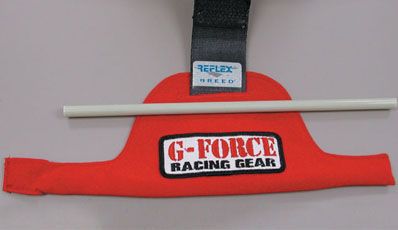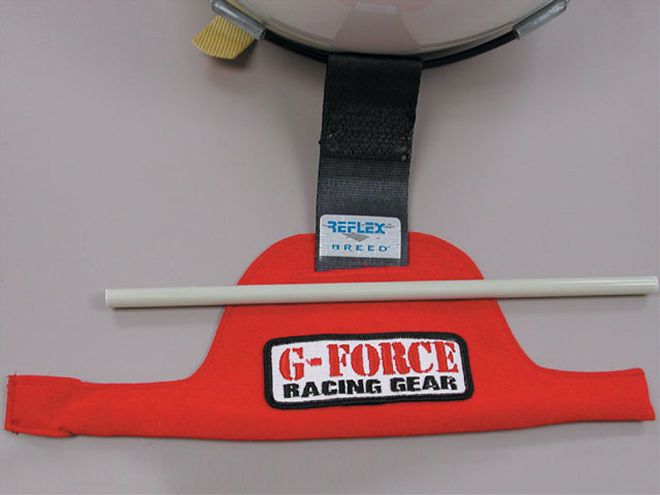
 The SRS-1 system features the TERM strap, the cable assembly affixed to reinforced supports, the cape, and reaction rod.
The SRS-1 system features the TERM strap, the cable assembly affixed to reinforced supports, the cape, and reaction rod.
Unless you've been living in a cave for the past two years, you know-or at least have heard-about head-and-neck restraints. G-Force Racing Gear has a new system for the racer that incorporates the helmet and shoulder belts and which, the company says, will not unnecessarily restrict the driver in an emergency egress situation.
Called the SRS-1 (its official name is the Supplemental Helmet Restraint System), G-Force has developed a system that reduces the potentially lethal forces generated in racing accidents, especially frontal crashes. The restraint devices currently on the market-the HANS Device and the Hutchens Device-do essentially the same thing: slow down the rotation of the head during impact with another car or the wall.
The HANS is a carbon-fiber collar worn around the driver's neck with straps attached to the driver's helmet. The Hutchens is a series of belts that wrap around the driver, using the lap belt and the driver's pelvis as its anchor point.
The SRS-1 uses a strap made of Tailored Elongation Restraint Material (TERM) attached to a cable assembly installed on the helmet via Kevlar(r)-reinforced anchors in the helmet shell. The helmet is another G-Force innovation. The other two helmet devices require dog rings to be attached through the helmet shell with no reinforcement supplied.
The final piece of the SRS-1 is the "Reaction Rod," a lightweight, high-strength composite rod made of pultrusion material (it is formed by pulling the material through a hot die) that fits behind the driver's shoulders underneath the shoulder belts. The rod is encased in a fire-retardant cloth "cape" attached to the bottom of the helmet and serves as the anchor for the TERM strap. The rod, in position under the belts, is what controls the motion of the head in conjunction with the Term Strap
The way it works, according to John Maloney of the Auto Research Center, the engineer behind the SRS-1, is fairly simple. "As you load, as the head and neck rotate over, the TERM webbing is going to restrain the head and neck to a point, then it's going to let go and limit the load seen by the head and neck," he said. Once the TERM strap is played out, the reaction rod takes over, using the stiffened shoulder belts as a guide. The rod slides up the back under the belts and further limits the movement of the head and neck.
"The other part of the equation is the helmet," Maloney said. "It has Kevlar(r)-reinforced attachments in the shell for the cable assembly, which means you don't get out the Black & Decker and drill your own holes in your helmet. I've seen aluminum rivets, big bolts, and hogged-out liners on helmets with other systems, and that concerns me a lot."
The cable assembly was designed to be in alignment with the forehead area of the front of the helmet. "At peak load, we want this cable in alignment with the forehead area to limit the rotation of the head and reduce neck tension," Maloney said. "You do have some reaction on the back of the head to help counter-react the rotation."
The SRS-1 can be tailored to the individual driver, and G-Force recommends its instructions on fitting the system be strictly followed. The TERM strap is the key to adjustability. Securus(r) is the brand name of the fiber, which is made by Honeywell Performance Fibers and licensed through Breed Technologies, and the belt comes in 1/2-inch increments.
One of the selling points of the system is its price. The price of the entire system, including the helmet, is less than $600. Without the helmet, the system will be $280. A Hutchens costs around $400 and the HANS is around $1,400. "The original intention of this system was to give IMCA racers and Saturday-night racers, guys walking around with wives and kids and a business, a chance to afford a good helmet and restraint system," Maloney said.
Another point Maloney makes is the relative ease of wearing the SRS-1. "Some of the drivers we've talked to say, 'Man, there's got to be a better way of doing this. We need something we can put on, get in the car, put our belts on, and go. If there's a fire, we can unstrap and get out.'"
In the development of the SRS-1, Maloney and his team purchased a Hutchens Device and a HANS Device for testing purposes. In dynamic testing, all three measured nearly the same in terms of load-limiting capability. Each restraint had its positives and negatives. "We're trying to get below the numbers put up by the HANS and the Hutchens with a simple, cost-effective, easy device, and we've done that," Maloney said.